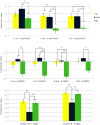Insula and amygdala resting-state functional connectivity differentiate bipolar from unipolar depression
- PMID: 28369737
- PMCID: PMC5464981
- DOI: 10.1111/acps.12724
Insula and amygdala resting-state functional connectivity differentiate bipolar from unipolar depression
Abstract
Objective: Distinguishing depressive episodes due to bipolar disorder (BD) or major depressive disorder (MDD) solely on clinical grounds is challenging. We aimed at comparing resting-state functional connectivity (rsFC) of regions subserving emotional regulation in similarly depressed BD and MDD.
Method: We enrolled 76 in-patients (BD, n = 36; MDD, n = 40) and 40 healthy controls (HC). A seed-based approach was used to identify regions showing different rsFC with the insula and the amygdala. Insular and amygdalar parcellations were then performed along with diagnostic accuracy of the main findings.
Results: Lower rsFC between the left insula and the left mid-dorsolateral prefrontal cortex and between bilateral insula and right frontopolar prefrontal cortex (FPPFC) was observed in BD compared to MDD and HC. These results were driven by the dorsal anterior and posterior insula (PI). Lower rsFC between the right amygdala and the left anterior hippocampus was observed in MDD compared to BD and HC. These results were driven by the centromedial and laterobasal amygdala. Left PI/right FPPC rsFC showed 78% accuracy differentiating BD and MDD.
Conclusion: rsFC of amygdala and insula distinguished between depressed BD and MDD. The observed differences suggest the possibility of differential pathophysiological mechanisms of emotional dysfunction in bipolar and unipolar depression.
Keywords: bipolar disorder; depression; functional magnetic resonance imaging; major depression.
© 2017 John Wiley & Sons A/S. Published by John Wiley & Sons Ltd.
Conflict of interest statement
None of the authors have any potential conflicts of interests to declare.
Figures



References
-
- Hirschfeld RMA, Lewis L, Vornik LA. Perceptions and impact of bipolar disorder: how far have we really come? Results of the national depressive and manic-depressive association 2000 survey of individuals with bipolar disorder. J Clin Psychiatry. 2003;64:161–174. - PubMed
-
- Forty L, Smith D, Jones L, et al. Clinical differences between bipolar and unipolar depression. Br J Psychiatry. 2008;192:388–389. - PubMed
-
- Judd LL, Akiskal HS, Schettler PJ, et al. A prospective investigation of the natural history of the long-term weekly symptomatic status of bipolar ii disorder. Arch Gen Psychiatry. 2003;60:261–269. - PubMed
-
- Judd LL, Akiskal HS, Schettler PJ, et al. The long-term natural history of the weekly symptomatic status of bipolar I disorder. Arch Gen Psychiatry. 2002;59:530–537. - PubMed
-
- Kamat Sa, Rajagopalan K, Pethick N, Willey V, Bullano M, Hassan M. Prevalence and humanistic impact of potential misdiagnosis of bipolar disorder among patients with major depressive disorder in a commercially insured population. J Manag Care Pharm. 2008;14:631–642. - PubMed
MeSH terms
Grants and funding
LinkOut - more resources
Full Text Sources
Other Literature Sources
Medical
Research Materials
Miscellaneous

